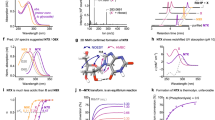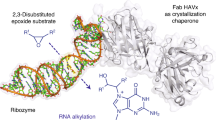Abstract
PANCREATIC ribonuclease catalyses the decomposition of a ribonucleic acid by a two-step mechanism: a transesterification followed by hydrolysis of the resulting cyclic phosphate1. The various mechanisms suggested can be classified as either “in-line” or “adjacent” depending on the relative geometry of the incoming and outgoing groups during the displacement reaction2 (Fig. 1). In particular, any simple mechanism in which it is assumed that the same group acts first as a general base toward the attacking nucleophile, then as a general acid toward the leaving group, implies an adjacent geometry. The alternative, in which there is a considerable movement of either the catalytic group or the substrate, is unlikely. The two steps may, however, have different mechanisms according to this criterion without violating microscopic reversibility, for a nucleoside is obviously not necessarily equivalent to a water molecule3.
This is a preview of subscription content, access via your institution
Access options
Subscribe to this journal
Receive 51 print issues and online access
$199.00 per year
only $3.90 per issue
Buy this article
- Purchase on Springer Link
- Instant access to full article PDF
Prices may be subject to local taxes which are calculated during checkout
Similar content being viewed by others
References
Barnard, E. A., Ann. Rev. Biochem., 38, 677 (1969).
Usher, D. A., Proc. US Nat. Acad. Sci., 62, 661 (1969).
Harris, M. R., Usher, D. A., Albrecht, H. P., Jones, G. H., and Moffatt, J. G., Proc. US Nat. Acad. Sci., 63, 246 (1969).
Findlay, D., Herries, D. G., Mathias, A. P., Rabin, B. R., and Ross, C. A., Nature, 190, 781 (1961).
Deavin, A., Mathias, A. P., and Rabin, B. R., Nature, 211, 252 (1966).
Westheimer, F. H., Accounts Chem. Res., 1, 70 (1968).
Wang, J. H., Science, 616, 328 (1968).
Hammes, G. G., Adv. Protein Chem., 23, 1 (1968).
Gassen, H. G., and Witzel, H., Europ. J. Biochem., 1, 36 (1967).
Ramsden, E. N., and Laidler, K. J., Canad. J. Chem., 44, 2597 (1966).
Roberts, G. C. K., Dennis, E. A., Meadows, D. H., Cohen, J. S., and Jardetzky, O., Proc. US Nat. Acad. Sci., 62, 1151 (1969).
Eckstein, F., FEBS Lett., 2, 85 (1968).
Eckstein, F., J. Amer. Chem. Soc., 92, 4718 (1970).
Hilmoe, R. J., Heppel, L. A., Springhorn, S. S., and Koshland, D. E., Biochim. Biophys. Acta, 53, 214 (1961).
Anbar, M., and Guttman, S., J. Appl. Rad. Isotopes, 5, 233 (1959).
Dunitz, J. D., and Prelog, V., Angew. Chem. Intern. Ed., 7, 725 (1968).
Author information
Authors and Affiliations
Rights and permissions
About this article
Cite this article
USHER, D., RICHARDSON, D. & ECKSTEIN, F. Absolute Stereochemistry of the Second Step of Ribonuclease Action. Nature 228, 663–665 (1970). https://doi.org/10.1038/228663a0
Received:
Issue Date:
DOI: https://doi.org/10.1038/228663a0
Comments
By submitting a comment you agree to abide by our Terms and Community Guidelines. If you find something abusive or that does not comply with our terms or guidelines please flag it as inappropriate.



